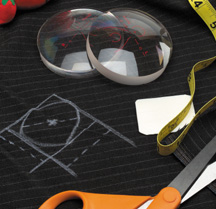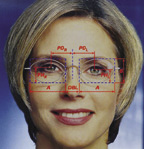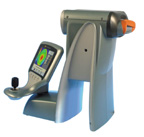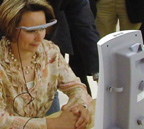
For many people, eyeglasses are the most customized product they will ever own. What could be more personal than looking through a pair of lenses made from your own prescription?
By Andrew Karp
Group Editor, Lenses and Technology
NEW YORK--For many people, eyeglasses are the most customized product they will ever own. What could be more personal than looking through a pair of lenses made from your own prescription?
Yet the concept of custom is being redefined for eyeglasses, just as it is for other consumer products ranging from apparel to sports equipment. There is evidence of a growing trend in the manufacturing, prescribing and dispensing of eyeglass lenses that is resulting in products that are personalized to even a greater degree than ever before.
Just as companies such as Brooks Brothers and Levi's now offer in-store measuring systems that can produce a custom-fitted suit or a pair of jeans, spectacle lens manufacturers, together with forward-looking eyecare practitioners, are enhancing the eyeglass purchasing experience by using innovative tools and techniques to engage consumers in new and novel ways.
Some industry observers speak excitedly of a "sea change" in the delivery of eyewear and eyecare when describing this emerging personalization trend. They say doctors and dispensers will need to acquire new diagnostic technologies as well as learn new measuring techniques, concepts and terminology that will allow them to explain the features and benefits of these lenses to patients. Those who succeed will strengthen the connection with their patients, create additional profit opportunities and further differentiate themselves from competitors.
Because the personalization trend is a recent development and because some additional new approaches will start to appear towards the end of this year and into 2006, most ECPs in the U.S. are only beginning to get acquainted with the latest lenses and diagnostic and dispensing technologies required to prescribe and dispense them.
A New
Generation
Much of the activity is focused
around the new generation of progressive addition lenses (PALs).
Manufacturers such as Essilor, Hoya, Johnson & Johnson, Pentax,
Rodenstock, Seiko, Shamir, SOLA, Carl Zeiss and others have
overcome the limitations of standardized front surface designs in a
series of base curves to create personalized PALs that promise the
ultimate in visual performance and comfort.
Although these new PALs can be loosely categorized together, each offers different features and different degrees of customization that allow the lens design to be optimized for each wearer. Some PAL designs are based on the position of the lens as worn by the patient. Others incorporate measurements based on the fit of a patient's frame. The latest development is proprietary systems from Essilor and SOLA that generate data for PAL prescriptions based a patient's eye and head movements.
"Personalized progressives are quite an exciting new development," said James Sheedy, OD, PhD, associate professor at Ohio State University College of Optometry and executive director of its Center for Ophthalmic Optics Research, which studies progressive lens performance. "In terms of the computer design of progressives, a lot of it has been due to the increase in manufacturing technology, specifically freeform technology."
The word "freeform" is part of the new nomenclature of personalized lenses that is spreading throughout the industry. Though it is sometimes incorrectly used in relation to the lenses themselves, "freeform" is a manufacturing method that generates complex aspheric and atoric curves on the front surface, rear surface or both surfaces of the lens. Lens surfaces are shaped directly on a lens blank, or "hockey puck" without using traditional tools and pads. Prescription laboratories use freeform technology, now available from companies such as Schneider Optical Machines, DAC Vision and Optotech, to optimize a manufacturer's progressive design. Industry observers believe that freeform technology, when coupled with new methods of ordering lenses, could significantly change the way PALs are produced and distributed over the next few years.
Growing the
Niche
In addition to benefiting patients,
personalized PALs offer greater profit opportunities for eyecare
professionals (ECPs). Yet personalized PALs are only an emerging,
high-end niche within the already crowded, highly competitive
progressive lens product category. To grow that niche, ECPs will
need to understand new concepts in PAL design and, in some cases,
learn new patient measurement techniques. In order to effectively
explain to patients the features and benefits of personalized PALs
and upgrade them to these top-of-the-line products, ECPs will also
need to differentiate between the growing number of brands and lens
designs on the market as well as parse the language of
manufacturers' competing product claims.
|
||
 |
"There needs to be much better communication to ECPs about this technology," said Sheedy. "It seems like these lenses have come about without any real fanfare or without real understanding on the part of ECPs. We need to have an understanding of the difference it makes to the patient."
According to some ECPs who have prescribed or dispensed personalized PALs, patients are often quick to recognize and appreciate the difference between their old lenses and new lenses.
"We've been dispensing Varilux Ipseo for about a month. My staff said patients put them on and can see better right away," said Peter Shaw-McMinn, OD, a private practitioner from Riverside, Calif. and assistant professor at Southern California College of Optometry.
Varilux Ipseo lenses are dispensed in conjunction with the Vision Print System, an FDA-cleared diagnostic device that the doctor or dispenser uses to measure visual behavior of head and eye movements. The head/eye ratio is used to optimize a patient's fields of vision and minimize the swim effect.
"With personalized PALs, the doctor can position these lenses better in the office," said Shaw-McMinn. "Everyone's different. Why should they get the same lens everyone else gets?"
At Davis, Duehr, Dean Optical Center in Madison, Wis., a growing number of patients are wearing the Shamir Autograph, a progressive lens based on Shamir's Direct Lens Technology, which is the result of the Prescriptor software developed by Shamir Optical Industry. The software combines the patient's Rx data and frame selection with Shamir's Eye-Point Technology, which simulates the human eye "at every angle of vision in each optical zone and each prescription range, thus improving accuracy and clarity and ensuring each patient's angle of vision," according to Shamir.
When Eye-Point Technology is combined with the personal "points" file generated by the software, a personalized progressive lens design with expanded vision zones, precision sphere power and cylinder accuracy is transferred to advanced machinery for the production of Shamir Autograph. Applying the prescription and progressive design together to the concave side of the lens brings the progressive lens design closer to the eye for wider parameters of vision in every zone.
"We've had a lot of success with Autograph once our staff members got over their hesitation of the pricing," said Andrea Reis, who is retail services supervisor. "Patients who get the lens rave about it. We've fit more than 100 pairs in the past two years."
Davis, Duehr, Dean charges about $335 for an uncoated pair of Shamir Autograph lenses and about $400 for an AR-coated pair, according to Reis. Most other premium progressives sold by Davis, Duehr, Dean retail for about $190 per pair, she said. Her dispensary orders the lenses through the Soderberg lab in Minneapolis, a process that only takes a few days.
Movin' On Up
Reis said her staff usually
presents the lenses to existing PAL wearers. "We ask the patient if
they would like the latest, most advanced PAL technology. We tell
them this lens will greatly reduce if not eliminate issues with
older PAL designs such as swim in the periphery. It also gives a
much better reading area."
Although some patients won't hesitate to pay top dollar for the latest PAL technology, value-conscious consumers, especially those already wearing PALs, may be a tougher sell.

|
| The Zeiss Gradal Individual lens allows ECPs to specify Rx, PD, fitting height, corneal vertex distance, pantoscopic angle, near distance and the shape of the frame. |
"When you tell an educated client who's been wearing a premium progressive that this new lens is so much better, they need to see a demonstrable difference. You don't want to have to explain away the extra cost," said Kate Giroux, owner of MacPherson Opticians, an upscale shop in Arlington, Va. "You want them to feel confident they're getting value at that higher price. The bottom line is they don't want to feel taken advantage of."
Giroux and her staff favor Zeiss Gradal Individual and Gradal Short i progressives. These lenses are personalized to the extent that ECPs can specify Rx, PD, fitting height, corneal vertex distance, pantoscopic angle, near distance and the shape of the frame.
"Because consumers are more educated today and have access to the internet, they sometimes pick up bad info on pricing and value," Giroux points out. "That puts a lot of pressure on the practitioner to sort it all out. At this point in progressive lens development, more of the onus will be on the lens manufacturers to educate the consumer directly, as they have done with the Transitions lens. The consumer isn't interested in the science of the lens as much as how it will help them see better."
The Right Tools
PAL suppliers, particularly those whose
lenses require the doctor or dispenser to take additional
measurements, are making sure ECPs have the necessary tools and
training to present the lenses properly. Mike Daley, president of
Essilor Lenses, believes the success of Varilux Ipseo and its
accompanying Vision Print System, depends on "intensive in-office
training, well coordinated lab to ECP communications and proper
practice targeting."
After completing a yearlong test market in the U.S., Essilor is beginning a staggered roll-out of Ipseo and Vision Print with a controlled number of doctors nationwide. "We hope to have 500 Vision Print Systems installed this year," Daley said. According to Daley, Varilux Ipseo is priced about 30 percent higher than Essilor's top standard design PAL, Varilux Panamic.
Until now, ECPs who dispensed Ipseo had to order the lenses from Essilor in France, a process that can take several weeks. However, Essilor is in the process of installing the necessary freeform surfacing equipment in its Avisia lab in Dallas. This will reduce turnaround time considerably, which will be a critical factor as demand for the lenses gradually increases. Asked to speculate about the potential market for Ipseo and other personalized PALs, Daley estimated the lenses could eventually account for "ten to fifteen percent of the progressive lens market."
 |
| The Z-View aberrometer from Ophthonix uses wavefront technology to measure lower and higher order aberrations, which are programmed onto a spectacle or contact lens. |
Other suppliers are more bullish. "I think all progressives will be made this way in less than five years," said Mike Rybacki, senior VP, sales and marketing, Seiko Optical Products, whose parent company, Seiko Epson, pioneered the use of freeform surfacing and polishing technology to make customized PALs about 10 years ago with the introduction of the Seiko 1.67 Super Proceed Internal Progressive. The design of the Internal Progressive places the progressive surface on the back side of the lens for wider visual fields and total control of off-center astigmatism and power error, according to Seiko. It provides aspheric compensation for each sphere, cylinder, axis and add, enabling over two million optically precise Rxs to be created.
"The [freeform] technology has huge implications," Rybacki continues. "From the lab standpoint, there are big advantages in inventory reduction and the elimination of tools, which are a headache now. The only problem the industry is faced with is throughput. With the current technology, you can produce more conventional, external PALs per hour than you can with personalized PALs. The cost of producing personalized PALs needs to be the same or less. If that's capable of happening, the industry will change very rapidly."
Currently, only a few U.S. labs are equipped with generators capable of producing freeform PALs, although that is expected to change as more manufacturers begin offering the equipment and prices drop. Many labs take orders for personalized PALs but do little to promote them. This has created a Catch-22 situation.
"In terms of growth percentage and market opportunity, I feel it's going to be a very small percentage of overall PAL numbers," said Shon Bjornberg, director of sales and marketing for Empire Optical of California, a major wholesale lab located in North Hollywood, Calif. "The reason is the perception of the doctors and opticians that any type of lens that creates more work for them or extra time to produce or more steps in the ordering process is going to turn both the staff away and patients away."
Bjornberg said Empire sells several personalized PALs, including the Zeiss Individual. "It's a good lens, but we only do about three a month. The biggest drawback is that there are too many steps involved in the ordering process. It takes patients four to six weeks to get the lens." He adds that Empire has also sold a few Seiko Internal Progressives, although there is a long turnaround time because the lens must be made in Japan.
"We haven't done anything to promote the Internal Progressive," said Seiko's Mike Rybacki. "It doesn't make sense since the product takes eight to 10 business days to come from Japan. Until the equipment is capable of doing this at various platforms in the market, it precludes us from putting horsepower into marketing. That will change when the equipment comes on line. They're getting close."
Rybacki said he believes it may take the commitment of large optical retail chains, with their deep pockets, to get the personalized PAL market moving. "Chains are getting more progressive in their approach," he noted. "They've been behind a lot of growth in various areas of the market like AR, polycarbonate and progressives. If chains get behind this, which I think they will, it will take off, provided the cost savings are there."
One supplier that has already introduced personalized progressives into the chain optical arena is SOLA. For the past two years, SOLA has worked with major retail chains in France such as Grand Vision as well as independent practices in Europe to develop and refine a dispensing system called iQ Solutions, which it is launching in the U.S. this spring. Consisting of advanced tools, technologies and services, iQ Solutions allows eyecare professionals to create a personalized ophthalmic lens solution for each patient, according to SOLA. Among the tools is iTracker, a device for measuring and recording an individual's visual behavior patters, which recently received a U.S. patent.
"Eyecare professionals have long felt the need for an accurate and reliable way to personalize lens selection for the individual patient," said Darrell Zoromski, SOLA's senior vice president, strategy and marketing. "Our research has shown that the best way is to involve the patient in an accurate simulation of real life visual tasks where detailed physiological feedback can be gathered. iTracker allows the ECP to make a recommendation that is personalized to the individual's visual behavior. This personalized recommendation could be the best match from a portfolio of existing lens designs, or a customized lens made to order using freeform lens processing technology."
In addition to iTracker, the iQ Solutions system includes iPilot, a handheld computer that assists retail staff with customer lifestyle profiling and customized lens selection. It also allows lifestyle-based lens design, material and treatment recommendations, or the production of a made to order lifestyle customized lens, according to SOLA. Another component of the system is the iImager, which enables digital measurement and fitting, presents value-added lens materials and treatments using digital images and enables virtual eyewear try-ons.
Karen Roberts, vice president of commercial development for SOLA, said iQ Solutions creates "a destination experience" for the consumer by involving them in the lens selection process "in a more intimate way."
"The technology could drive a substantial shift in the industry," she asserted. "The ECP can draw from a huge knowledge base to categorize consumers." She also points out that the system may help consumers understand why sophisticated lens technology costs more, because "it brings science and rigor to prices."
The 'Wow'
Factor
With the number of new lens
products, dispensing systems and processing technologies
increasing, it is only a matter of time before the personalized PAL
market begins to gather momentum in the U.S.
| SOLA's iTracker (above) monitors and records an individual's visual behavior patterns. The measurements are used to create personalized progressives such as SOLAOne. The iPilot (below) assists retail staff with customer lifestyle profiling and customized lens selection. |
 |
Savvy ECPs are well aware of the "wow factor" they create for patients when they experience new technology in the exam room room or dispensary. As Shaw-McMinn commented, "It's important for the patient to see new technology every time they visit your office."
In addition to using Essilor's Vision Print System to prescribe and dispense Varilux Ipseo, Shaw-McMinn's practice recently acquired a new Z-View aberrometer from Ophthonix, a San Diego-based company. The instrument produces conventional sphere, cylinder and axis measurements and separately measures high order aberrations. Using these measurements, dispensers can generate highly precise wavefront-guided spectacle and contact lens prescriptions. The lenses offer up to 20/10 visual acuity with superior clarity and crispness, according to chief executive officer Andreas Dreher, PhD. Ophthonix is currently testing the lens with various ECPs in California.
"The Ophthonix abberometer really positions the individual concept well," said Shaw-McMinn. "Patients get a printout of their measurements and can see how they differ from another person's."
"Wavefront technology and personalized PALs will make buying eyewear much more sexy," said Shaw-McMinn, who believes personalized lenses could reach fifty percent of the market or more someday.
Using technology to help present personalized lenses to patients will take a "paradigm shift" for doctors in terms of how they do business, said Shaw-McMinn. "Doctors will have to buy equipment which will help them define their products," he pointed out. "Now they feel 'why should I spend money on equipment?' They want to focus on TPAs (therapeutic pharmaceutical agents). But they should look at how they can use these technologies to improve patients' lives."












